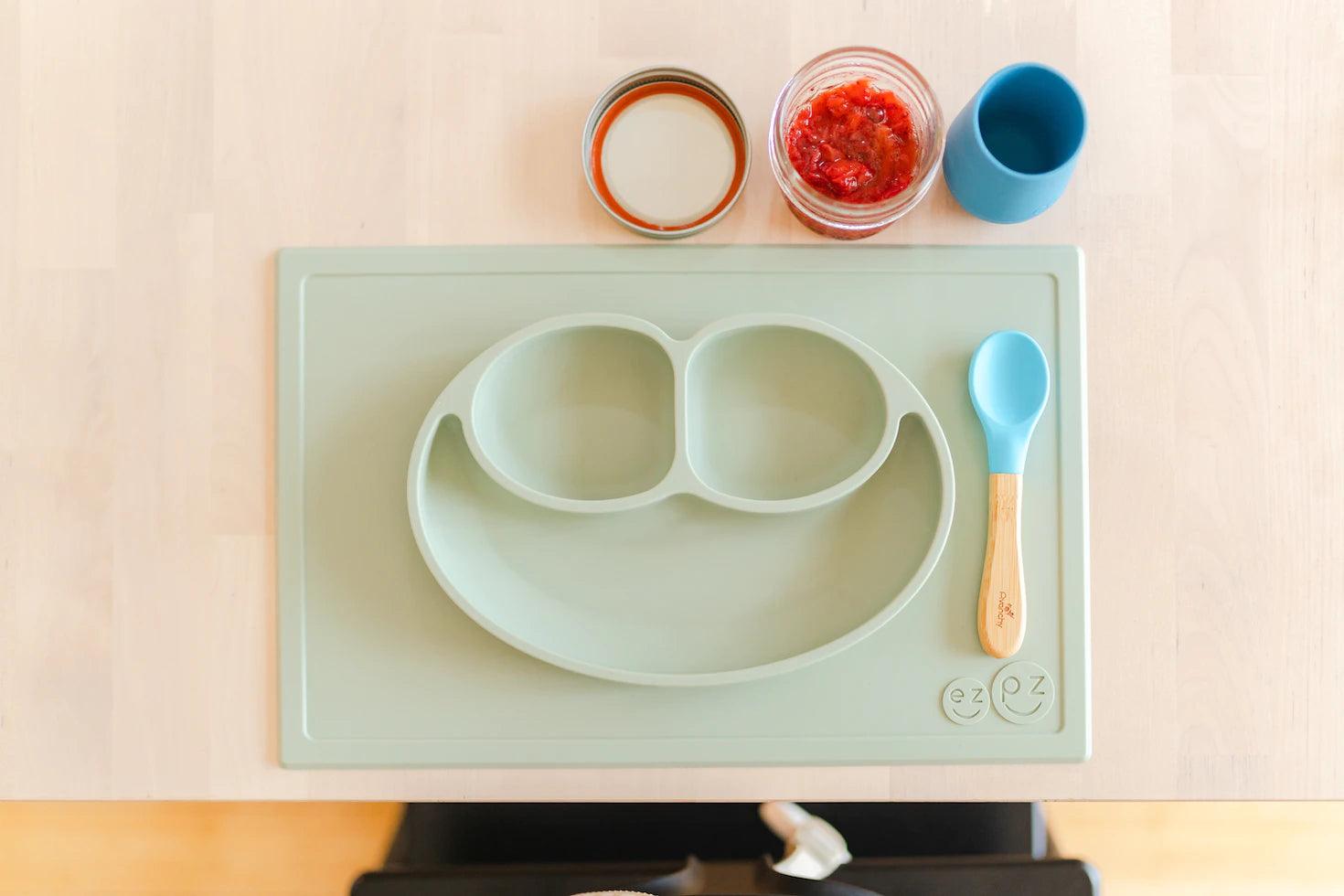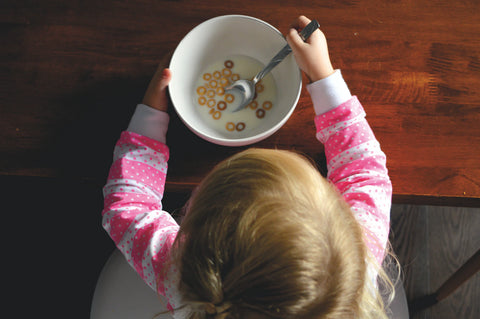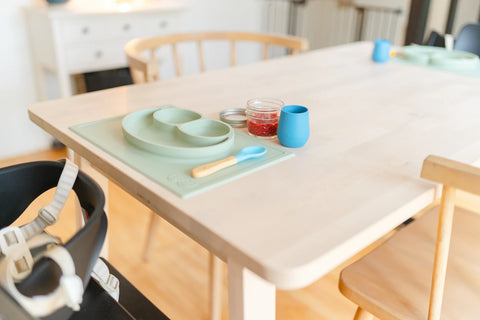3 Tips for Baby Tableware
•Posted on October 09 2022

Raising a child is not an easy task, and there are always many unexpected things that happen in the process. On the issue of baby meals, baby tableware is a topic that cannot be bypassed. Tableware, used every day, who can not leave. Parents are very careful to select the tableware that they want to enter.
In the end, what material is the safest tableware for babies? How to choose the right tableware, how to use good tableware, to solve the baby's meal problem? This is what we need to know in advance before feeding the baby.
Table of Content:
- Can children and adults use the same tableware?
- Preparation for choosing baby tableware
- Material of baby tableware
- How to choose baby tableware?
Can children and adults use the same tableware?
Children who are already in kindergarten can barely use the same tableware as adults. However, some adult tableware may not be suitable for children, such as sharp forks, spoons, may cause trauma; glass, ceramic products, children can not hold unstable easily broken. Some tableware may not be suitable for high-temperature sterilization, and may even be attached to oil. There are also some plastic products, may be used gradually up the edges, will make the contaminants easy to precipitate, and even some small parts, put into the mouth, there may be a risk of inducing airway obstruction. If there are holes in the tableware, the child's tiny fingers can just plug in, accidentally easy to pinch or scratch. Even the child's skin may be more sensitive, choose tableware also have to pay attention to its thermal conductivity, to guard against child burns. Some plates and rice bowls, it is also best to have a design that prevents tipping.
So we suggest that from the time the baby eats supplementary food, choose a special meal for the child, so that the child develops good eating habits.

Preparation for choosing baby tableware
Early baby adaptation to tableware
Complementary foods can be added at the age of six months, before which parents can introduce tableware for him early. At about four months of age, we can purchase a variety of spoons of different materials, sizes and shapes for the baby, and then give the small spoons to him to explore during the day when he is in a good mental condition and happy.
The baby's method of exploration is usually chewing. At this time, the spoon is naturally delivered to the baby's mouth, and the baby will quickly adapt to this new friend by chewing on different materials, shapes and sizes of spoons. When the baby eats with the spoon later, he or she will not resist because of the unfamiliarity with the spoon.
However, when babies explore the spoon, because the spoon has a handle, the baby will easily put the handle into the mouth, parents must pay attention to the supervision of the baby to avoid the baby because of poor control of the handle, poking the throat to produce danger.
The hand is better than a good spoon
We often see babies start out using a spoon for a while, but soon throw it away and go straight to their hands. Whether babies are just starting to add complementary foods or are already three years old, their hands have always been their favorite tool for eating.
Using the hands to grasp food is not only convenient and easy to control, but by grasping food, babies can also use their hands to feel the shape, nature, size, and temperature of the food and give themselves a further understanding of the food... what a great experience! For babies whose hand control is still developing, isn't it much easier to just use your hands than having to use a spoon or chopsticks? So if we see our child grabbing food with his hands, we can give him more encouragement.
Hand control of spoons and chopsticks still takes time to practice, but feeling food and enjoying it with your hands can start now. Getting your baby interested in eating and learning to eat on his own is most important!
Material of baby tableware
Melamine ware
The features are very light, hard, smooth surface, not easy to break, and there is no BPA inside, put in the dishwasher can also be, so commonly used in children's tableware. However, this material is melamine-formaldehyde resin as raw material, with the microwave oven may have some formaldehyde and melamine migration, there is still a certain risk, although this will only be in the more extreme cases will have a small amount of migration.
It is generally recommended that such products do not hold oil and acidic substances for a long time, and do not put them in the microwave or oven to heat, or mainly used to put cold or warm food can be.
Silica gel
Silicone tableware is also used more, features are mainly very soft, very smooth, do not worry about stabbing the baby, and high temperature resistance, and can reduce the heat of tableware, delaying the loss of food temperature.
But be sure to pay attention to avoid adsorbing some oil and dirt, timely cleaning of tableware. In addition, when buying to pay attention to the choice of products that do not smell any pungent odor.
Be aware of plasticizer
Plastic tableware for young children is still quite a lot, such as polypropylene (PP) and so on, we are more concerned about plasticizers. The previously mentioned phthalates (PAEs) and bisphenol A (BPA) are common plasticizers, especially the latter and human estrogen has a similar structure, but also may affect the human reproductive nerve as well as the immune system, BPA in the body is more likely to accumulate down. Overall, there is a growing body of evidence about the dangers of BPA.
Generally there is a cycle mark on the bottom of the plastic product, if it is number 3 and number 7, he is likely to contain BPA.
Overall, pay attention to the label of the product, such as whether it can be used for microwave heating, if so, the general instructions are safer.

How to choose baby tableware?
Children's tableware selection of the four elements:
Product label information
"Safety" is especially important for baby products, baby tableware is also. We need to check the product or its sales package labeling, instructions should be consistent with the use of the content of the requirements.
Function
Tableware selection to reflect the characteristics of children, small and chic, lightweight and fall-resistant. Preference for younger children with suction cups, tableware with handles.
Appearance
Look at the appearance. Sensory odor-free, the appearance of no cracks, bulges, burrs and other obvious defects. Avoid choosing cutlery with sharp cuts or sharp knives and forks to prevent injury to children.
Color
Try to choose less brightly colored tableware, pigments may contain heavy metals and other toxic and harmful substances, in the heating or serving acidic food, such substances are more likely to migrate and precipitate, and food into the body of children at the same time. You can give priority to the selection of plain or stainless steel children's tableware.
There are many baby tableware on the market, spoons, forks, bowls and so on, how do we choose the right tableware for our children?
Spoon
First of all, because babies tend to chew on spoons when they first start exploring the use of spoons, we can first choose some spoons with higher safety for babies. Soft-headed spoons and round-sided plastic spoons have softer heads and are suitable for adding complementary foods at the beginning. It allows babies to chew and reduces the risk of babies being poked in the throat by the spoon.
Of course, some parents will feedback that soft-headed spoons do not feel as good as plastic or stainless steel spoons when scooping food, so if the baby has adapted to eat with a spoon after the supplemental food, we can also switch to plastic or stainless steel spoons.
Babies who have just started to add complementary foods are not quite able to open their mouths wide and round, so we need to choose a spoon with a smaller head for our babies to feed them easily. It is recommended that the size of the spoon head is 1/2-2/3 of the size of the baby's mouth, which is more convenient for babies to learn how to open their mouths and hold the spoon, but it will not be difficult to stuff the spoon into their mouths because the spoon head is too big.
In addition, after adding complementary foods for a period of time, babies start to do things on their own, but it is likely that their hand movements still remain at a level where they can only "grab" and "put". Therefore, when the baby picks up the spoon, the spoon head can only face the side, not the baby's mouth to send the food in. At this point, the curved spoon can solve this problem very well.
Babies do not always sit honestly when eating complementary foods, and are very likely to grab the spoon from our hands. We can prepare spoons with thick and short handles and encourage babies to try to explore with the spoons themselves.
This will allow the baby to practice gripping the spoon and also prevent the baby from stuffing the spoon or handle too much into the mouth to ensure safety. And parents can choose a long-handled spoon, easy to reach into the thermos to scoop food and feed the baby.
The color of the spoon is recommended to try to choose a simple color rather than too fancy, to avoid distracting the baby when eating.
| Time | Type | Method |
|
First added complementary food |
Soft-headed spoon with rounded edge plastic spoon (long handle, small spoon head) | Mother feeding |
|
Adaptation period |
Plastic spoon, stainless steel spoon (long handle, small spoon head) | Mother feeding |
|
Self exploration period |
Plastic spoon, curved head spoon (thick and short handle, simple pattern) | The child eats on his own |

Fork
Fork is suitable for eating some solid food with shape and long food such as noodles.
At the beginning of the baby's movement stability, precision is not so high, you can choose fork food parts with serrated fork, food is more difficult to fall, increasing the chances of success.
Bowl
You can choose a bowl with strong suction and a certain depth. It can make it easier for baby to scoop the food, but also to avoid baby scooping the food after picking up the fly out, there is a bowl rim is even better.
Unless it is a very small baby who just started to eat supplementary food, we recommend the separation type of dinner plate. First of all, it is convenient for rationing and easy for children to have a sense of food diversity; secondly, it can also avoid stringing of flavors, let the food retain the deliciousness of cooking and let children know more about each different ingredient.
Comments
0 Comments
Leave a Comment